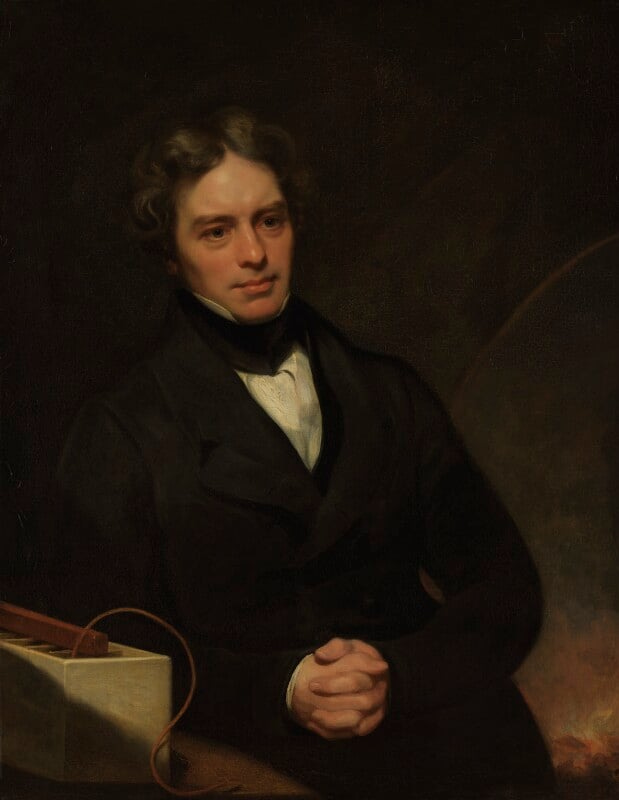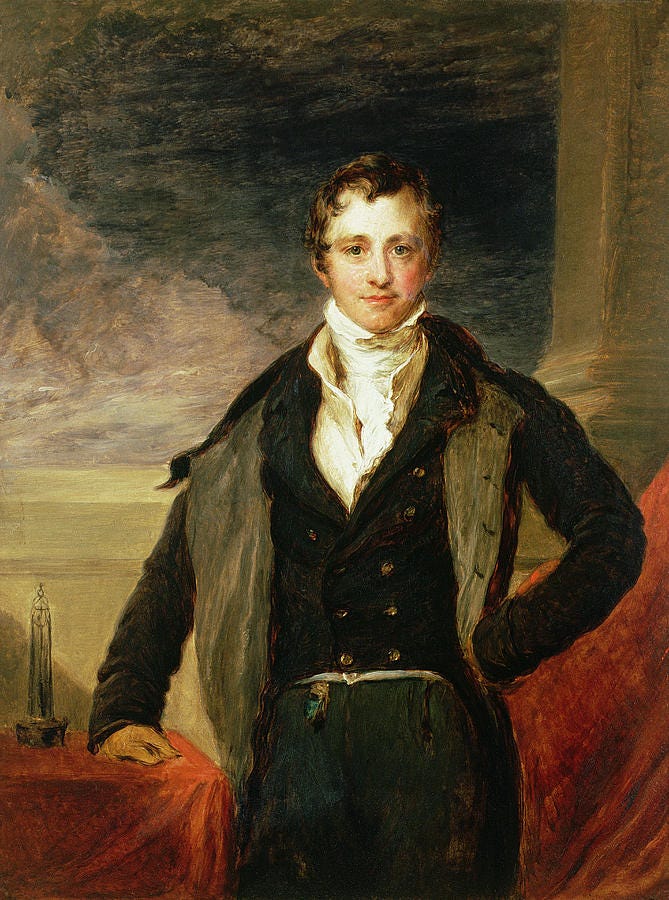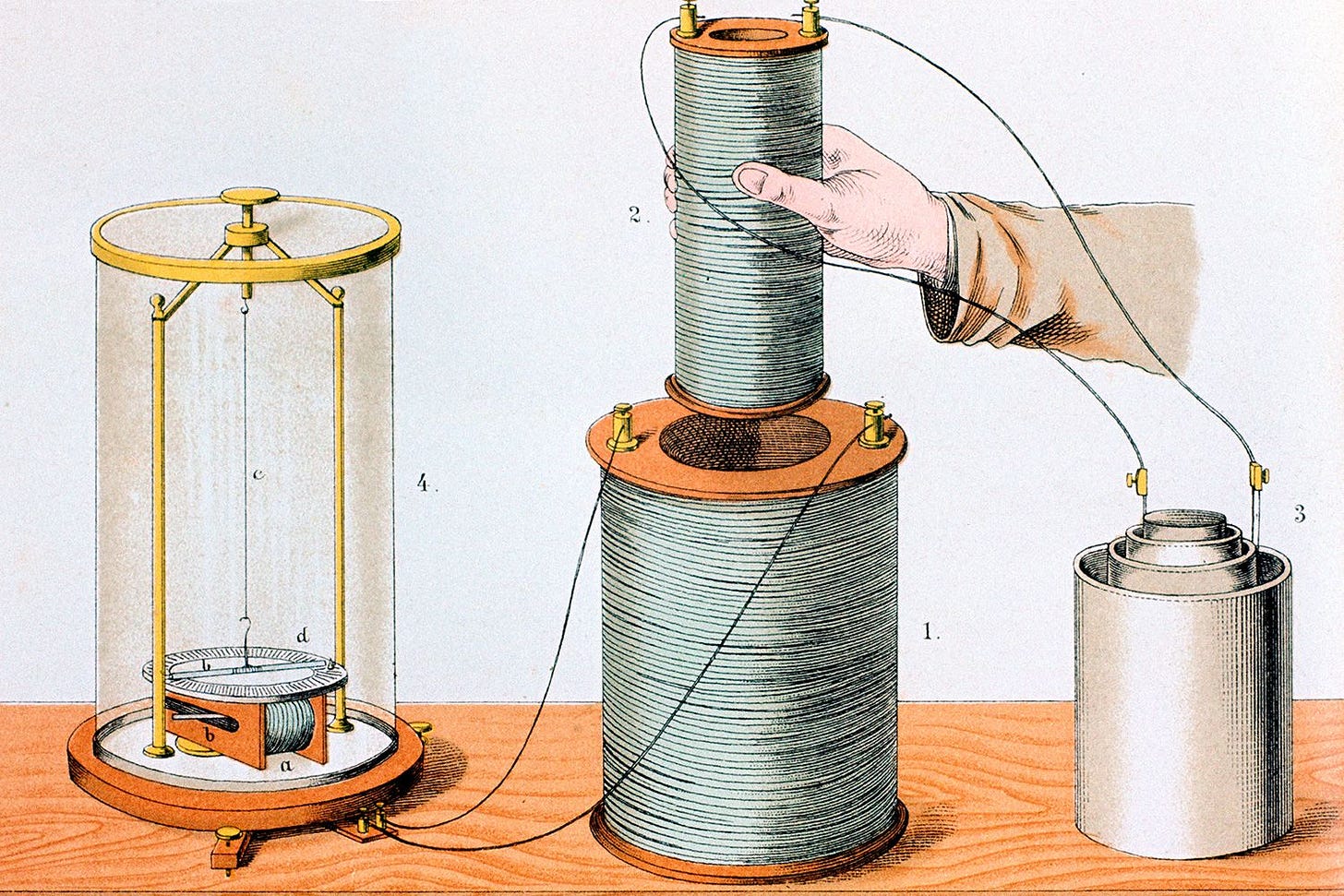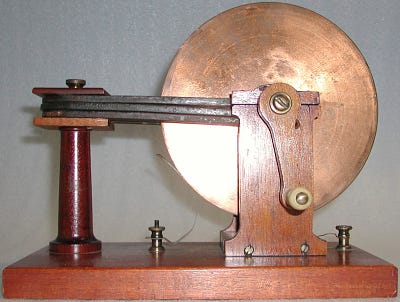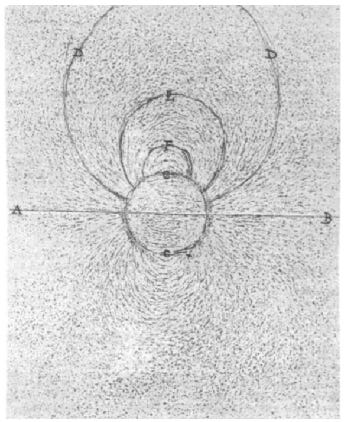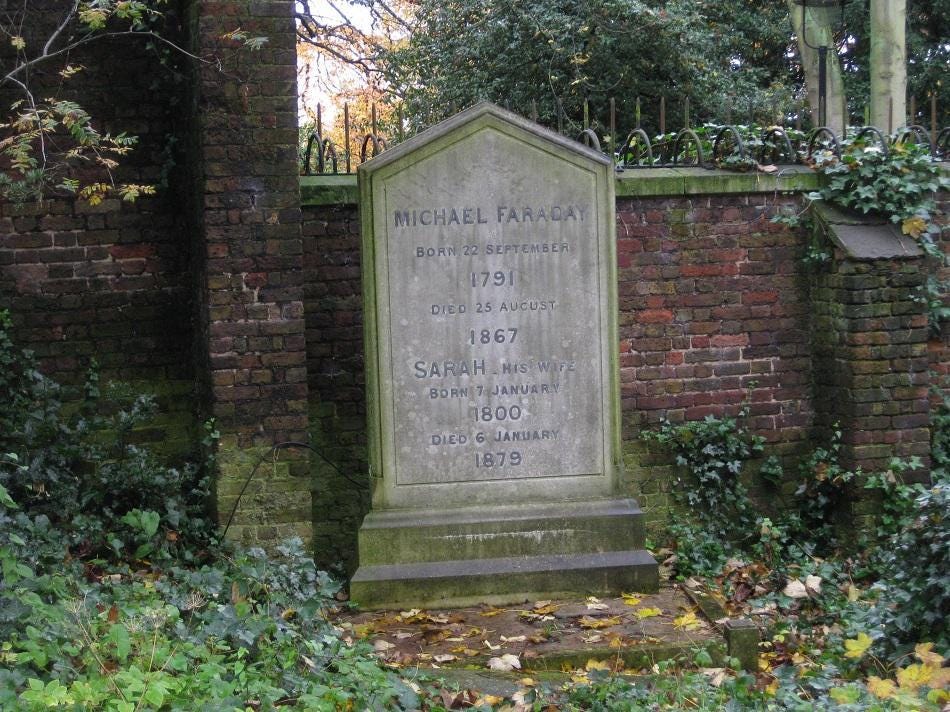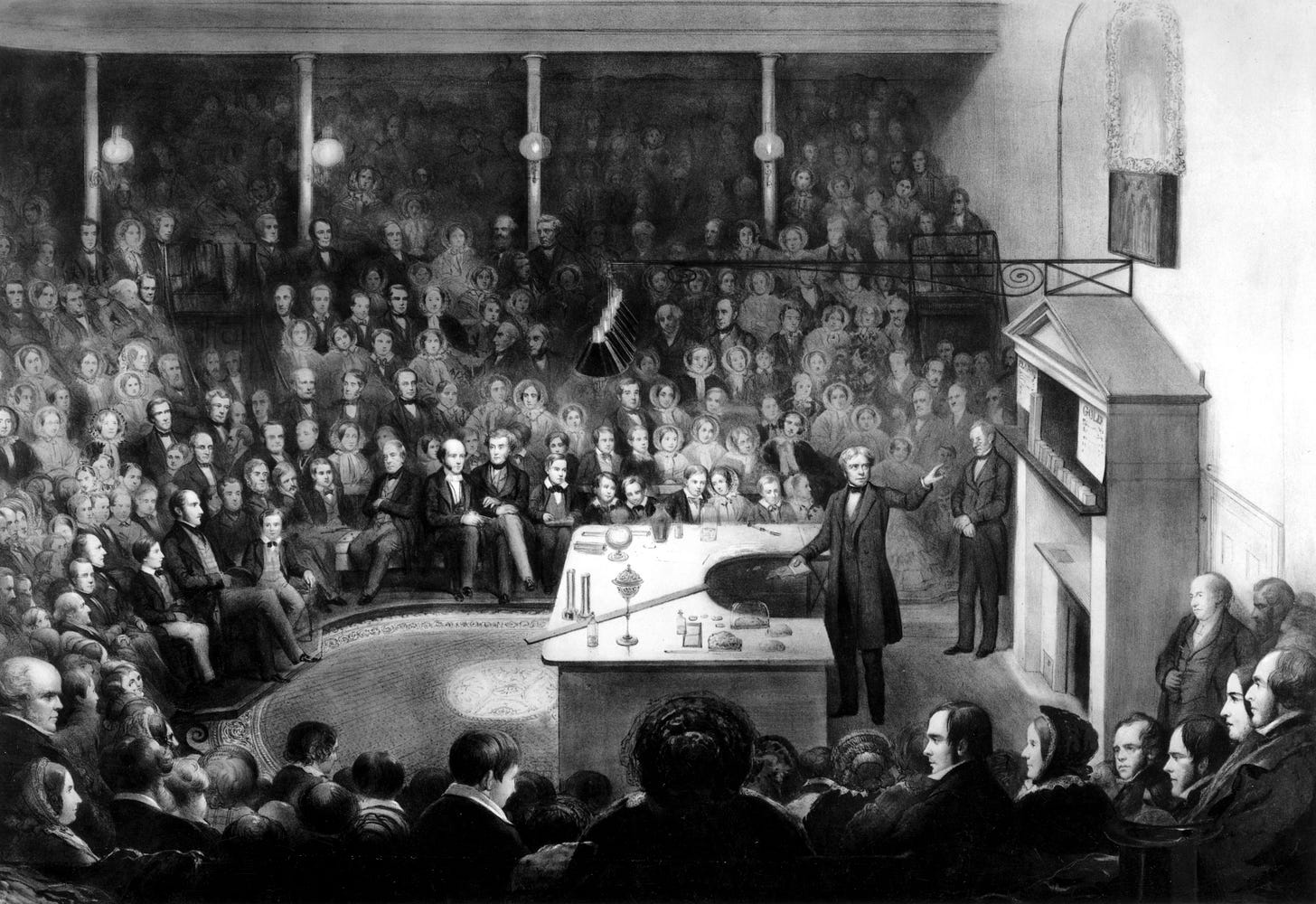If you enjoy this content and would like to support it consider becoming a paid subscriber. For just £3.50/month get access to all Electrochemical Insights along with other benefits such as leaving comments, asking questions, and suggesting future content.
The annals of science are filled with visionaries whose ideas forever changed the world, but few embody the spirit of discovery like Michael Faraday. Born into poverty in 1791 and denied the privilege of formal education, Faraday’s relentless curiosity and self-taught brilliance propelled him to become one of the most influential scientists of all time. His work on electromagnetism and electrochemistry laid the foundation for technologies that power our modern world. Yet, Faraday’s story is as much about the triumph of character as it is about scientific achievement.
From Poverty to Possibility
Michael Faraday was born on 22 September 1791 in the village of Newington Butts, Surrey—now part of South London—to James Faraday, a blacksmith, and Margaret Hastwell, a devoted homemaker. James moved Margaret and two children from the north west of England to London during the winter of 1790 in search of work. Michael was born the following autumn, the third of four children in the Faraday family Michael and his siblings were hard put to get enough to eat, as their father suffered with poor health and struggled to find regular employment. In his later years Faraday recalled being given one loaf of bread that had to last him for the week. Despite these challenges, Faraday’s mother provided emotional strength and fostered a household built on faith and perseverance.
Faraday’s formal education ended after basic literacy and numeracy lessons at a local Sunday school. By the age of 14, he was apprenticed to a bookbinder, a job that might have stifled another’s potential. But for Faraday, it was an open door. Surrounded by books, he immersed himself in science, reading voraciously. One article on electricity in the Encyclopaedia Britannica captivated him, sparking experiments with homemade equipment fashioned from discarded bottles and wood. He also built a weak voltaic pile with which he performed experiments in electrochemistry.
Faraday’s early explorations were modest yet profound, igniting a passion that would guide him for the rest of his life.
The Moment That Changed Everything
In 1812, at the age of 20 Faraday’s life took a dramatic turn. When he was nearing the end of his apprenticeship a customer at the bookshop offered him tickets to attend a series of lectures by Sir Humphry Davy, one of the era’s leading chemists, at the Royal Institution. Faraday sat spellbound, taking meticulous notes that he later bound into a 300-page book and sent to Davy, along with a letter asking for a job. Though initially there were no positions available, fortune soon intervened. When one of Davy’s assistants was dismissed for brawling, Faraday was offered the role. Faraday began as Davy’s laboratory assistant and learned chemistry at the elbow of one of the greatest practitioners of the day.
“Faraday was Davy’s greatest discovery and most important scientific contribution” - unknown
Working alongside Davy, Faraday gained first hand experience with cutting-edge research. Davy’s work on atomic theory, particularly Ruggero Giuseppe Boscovich’s concept of atoms as mathematical points surrounded by force fields, deeply influenced Faraday’s own ideas about matter and electricity. Boscovich’s theory suggested that these fields could be strained or placed under tension—a concept that Faraday later applied to his ground breaking work in electromagnetism.
Chemistry: The First Chapter
Faraday’s early years at the Royal Institution were marked by a series of chemical discoveries that established his reputation as a skilled experimentalist. He investigated the properties of gases, becoming the first to liquefy substances like chlorine and demonstrating that even “permanent gases” could exist in liquid form under the right conditions. In 1825, Faraday isolated and described benzene, an organic compound that would go on to play a central role in modern chemistry. His work also extended to metallurgy, where he contributed to the development of steel alloys and optical glass.

By the time his apprenticeship with Davy ended in 1820, Faraday had become a master chemist. His reputation as an analytical chemist led to opportunities beyond the laboratory, including serving as an expert witness in legal trials and consulting on industrial projects. But it was his work in electricity and magnetism that would truly transform science.
Revolutionising Electromagnetism
Faraday’s most transformative work began in the 1820s, inspired by Hans Christian Ørsted’s discovery that an electric current produces a magnetic field. Building on this insight, Faraday devised an experiment in 1821 that led to the creation of the first electromagnetic rotary device—the precursor to the modern electric motor.
In 1831, Faraday conducted his most famous experiment, discovering electromagnetic induction. By wrapping insulated wire around an iron ring and connecting one coil to a battery, he observed that a current was induced in a secondary coil when the primary circuit was completed or interrupted. This principle, now known as Faraday’s law of induction, demonstrated that a changing magnetic field could produce an electric current. It formed the foundation for technologies like transformers, electric generators, and modern power grids.
Faraday’s ingenuity didn’t stop there. He constructed the first dynamo, a device that converted mechanical energy into electrical energy, paving the way for practical electricity. His experiments also revealed the concept of “lines of force,” which he used to visualise electric and magnetic fields. Although initially dismissed, this idea later became the foundation for James Clerk Maxwell’s equations of electromagnetism.
Electrochemistry: Defining the Rules
Faraday’s contributions to electrochemistry were equally ground breaking. He formulated the laws of electrolysis, which established a direct relationship between the quantity of electricity passed through a solution and the amount of chemical change that occurred. These laws not only advanced theoretical chemistry but also enabled practical applications like electroplating and battery development.
Faraday introduced terms that remain essential in modern science, including anode, cathode, electrode, and ion. His meticulous experiments and intuitive understanding of electrical phenomena laid the groundwork for future discoveries in both chemistry and physics.
A Vision of the Invisible
One of Michael Faraday’s most remarkable traits was his ability to conceptualise abstract phenomena in ways that bridged the gap between observation and theory. Unlike many of his contemporaries, who viewed electricity and magnetism as fluid-like substances flowing through wires or as particles carrying charge, Faraday proposed a ground breaking alternative: that these forces existed as fields extending through space. He introduced the concept of “lines of force” to describe the patterns formed by these fields, a revolutionary idea that allowed invisible interactions to be visualised and studied systematically.
Faraday’s insights were rooted in his experimental work. For example, he demonstrated how a magnetic field could influence materials or induce currents in nearby conductors. Using iron filings sprinkled around a magnet, he showed that the “lines of force” were not merely theoretical constructs but physically meaningful entities that represented the structure of the field. Faraday viewed these lines as carriers of force that acted across space, even in the absence of direct contact—a radical departure from the Newtonian framework of action at a distance.
Although initially met with scepticism, Faraday’s ideas profoundly influenced physics. His concept of fields provided the foundation for James Clerk Maxwell’s mathematical formulation of electromagnetism. Maxwell’s equations unified electricity, magnetism, and optics into a coherent framework, describing how electric and magnetic fields propagate as waves of energy. These equations remain a cornerstone of modern physics, underpinning technologies like wireless communication, radar, and quantum mechanics.
“Faraday is, and must always remain, the father of that enlarged science of electromagnetism.” - James Clerk Maxwell
Faraday’s influence extended to Albert Einstein, whose own theories of relativity were built upon Maxwell’s work. Einstein famously kept a portrait of Faraday on his study wall, alongside those of Isaac Newton and James Clerk Maxwell. For Einstein, Faraday’s ability to grasp the invisible forces shaping reality symbolised the power of human intuition and creativity in advancing science.
“Would Faraday have discovered the law of electromagnetic induction if he had received a regular college education?” - Albert Einstein
The Faraday Effect and the Unity of Forces
Faraday’s unshakable belief in the unity of nature’s forces drove much of his scientific work. He was convinced that electricity, magnetism, and light were interconnected manifestations of a single, underlying principle. This conviction led him to one of his most significant discoveries: the Faraday effect.
In 1845, Faraday showed that a magnetic field could rotate the plane of polarised light passing through a material. By aligning a beam of polarised light with the magnetic lines of force in a transparent medium, he observed that the polarisation angle shifted when the magnetic field was applied. This effect, which directly linked magnetism to light, provided the first experimental evidence of a deeper connection between electromagnetism and optics. Faraday himself recognised the importance of this discovery, noting in his laboratory journal:
“I have at last succeeded in magnetising a ray of light.”
The Faraday effect not only confirmed his theory of “lines of force” but also laid the groundwork for future explorations of electromagnetic radiation. Decades later, Maxwell built upon this work to develop the theory that light is an electromagnetic wave—a discovery that transformed our understanding of the universe.
Faraday’s drive to explore these connections was deeply influenced by his Sandemanian faith, which emphasised the unity and order of creation. He saw the natural world as a harmonious system, governed by laws that reflected divine wisdom. This perspective inspired his quest to uncover the fundamental principles underlying natural phenomena, guiding his meticulous approach to experimentation.
Humble Genius
Despite his monumental achievements, Faraday remained remarkably humble throughout his life. He turned down both a knighthood and the presidency of the Royal Society, believing that such honours conflicted with his values. Faraday preferred to be known simply as “Mr. Faraday,” a title that reflected his commitment to modesty and scientific integrity.
Faraday’s humility extended to his personal life as well. He and his wife, Sarah, lived a simple and quiet existence in their quarters at the Royal Institution. Faraday’s rejection of wealth and status stemmed from his belief that the pursuit of knowledge was its own reward. When offered burial in Westminster Abbey, he declined, choosing instead a modest grave in Highgate Cemetery.
Faraday’s approach to life and science was guided by a deep sense of purpose. He once remarked that his greatest ambition was not fame or fortune but to understand and communicate the truths of nature. This philosophy shaped not only his scientific work but also his relationships with colleagues and students, whom he inspired with his generosity and passion for discovery.
Legacy and Modern Impact
Faraday’s legacy is woven into the fabric of modern life. His discoveries underpin a vast array of technologies, from the electric motors that power our appliances and vehicles to the generators that produce electricity for homes and industries. The SI unit of capacitance, the farad, honours his name—a testament to his enduring impact on science and engineering.
Faraday’s influence extends beyond the laboratory. His Christmas Lectures at the Royal Institution, which he began delivering in 1827, remain a celebrated tradition to this day. These lectures, designed to make science accessible to young people, showcased Faraday’s extraordinary ability to explain complex ideas in simple, engaging terms. Through live demonstrations and vivid storytelling, he brought the wonders of science to audiences of all ages, inspiring future generations of scientists.
Faraday’s pioneering work also laid the groundwork for emerging fields like quantum mechanics and nanotechnology. His early experiments on the optical properties of gold colloids, for example, marked the beginnings of nanoscience—a field that continues to transform medicine, electronics, and materials science.
Reflections on a Remarkable Life
Michael Faraday’s life is a testament to the transformative power of curiosity, perseverance, and humility. Born into poverty with no formal education, he rose to heights few could have imagined, fundamentally changing the way we understand and harness the forces of nature. His work not only revolutionised science but also demonstrated the importance of intuition, creativity, and ethical responsibility in advancing human knowledge.
Faraday’s story is a powerful reminder that true greatness lies not in titles or material wealth but in the impact we leave on the world. His journey, from a bookbinder’s apprentice to one of history’s most celebrated scientists, continues to inspire anyone who dreams of unlocking nature’s secrets.
As we stand on the shoulders of giants like Faraday, let us honour his legacy by fostering curiosity, embracing discovery, and pursuing the truth.
Thank you for supporting Electrochemical Insights!




